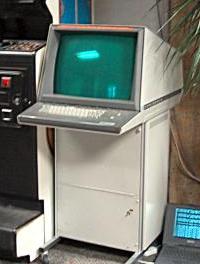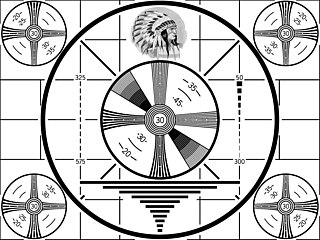
A cathode-ray tube (CRT) is a vacuum tube containing one or more electron guns, which emit electron beams that are manipulated to display images on a phosphorescent screen. The images may represent electrical waveforms (oscilloscope), pictures, radar targets, or other phenomena. A CRT on a television set is commonly called a picture tube. CRTs have also been used as memory devices, in which case the screen is not intended to be visible to an observer. The term cathode ray was used to describe electron beams when they were first discovered, before it was understood that what was emitted from the cathode was a beam of electrons.

The Vectrex is a vector display-based home video game console–the only one ever designed and released for the home market, developed by Smith Engineering. It was first released for the North America market in November 1982 and then Europe and Japan in 1983. Originally manufactured by General Consumer Electronics, it was later licensed to Milton Bradley after they acquired the company. Bandai released the system in Japan.

Allen Balcom DuMont, also spelled Du Mont, was an American electronics engineer, scientist and inventor best known for improvements to the cathode ray tube in 1931 for use in television receivers. Seven years later he manufactured and sold the first commercially practical television set to the public. In June 1938, his Model 180 television receiver was the first all-electronic television set ever sold to the public, a few months prior to RCA's first set in April 1939. In 1946, DuMont founded the first television network to be licensed, the DuMont Television Network, initially by linking station WABD in New York City to station W3XWT, which later became WTTG, in Washington, D.C. DuMont's successes in television picture tubes, TV sets and components and his involvement in commercial TV broadcasting made him the first millionaire in the business.

Video camera tubes were devices based on the cathode ray tube that were used in television cameras to capture television images, prior to the introduction of charge-coupled device (CCD) image sensors in the 1980s. Several different types of tubes were in use from the early 1930s, and as late as the 1990s.

An X-ray tube is a vacuum tube that converts electrical input power into X-rays. The availability of this controllable source of X-rays created the field of radiography, the imaging of partly opaque objects with penetrating radiation. In contrast to other sources of ionizing radiation, X-rays are only produced as long as the X-ray tube is energized. X-ray tubes are also used in CT scanners, airport luggage scanners, X-ray crystallography, material and structure analysis, and for industrial inspection.

Tennis for Two is a sports video game that simulates a game of tennis, and was one of the first games developed in the early history of video games. American physicist William Higinbotham designed the game in 1958 for display at the Brookhaven National Laboratory's annual public exhibition after learning that the government research institution's Donner Model 30 analog computer could simulate trajectories with wind resistance. He designed the game within a few hours, after which he and technician Robert V. Dvorak built it over a period of three weeks. The game was displayed on an oscilloscope and played with two custom aluminum controllers. Its visuals show a representation of a tennis court viewed from the side, and players adjust the angle of their shots with a knob on their controller and try to hit the ball over the net by pressing a button.

OXO is a video game developed by A S Douglas in 1952 which simulates a game of noughts and crosses (tic-tac-toe). It was one of the first games developed in the early history of video games. Douglas programmed the game as part of a thesis on human-computer interaction at the University of Cambridge.

Direct-view bistable storage tube (DVBST) was an acronym used by Tektronix to describe their line of storage tubes. These were cathode ray tubes (CRT) that stored information written to them using an analog technique inherent in the CRT and based upon the secondary emission of electrons from the phosphor screen itself. The resulting image was visible in the continuously glowing patterns on the face of the CRT.

A monoscope was a special form of video camera tube which displayed a single still video image. The image was built into the tube, hence the name. The tube resembled a small cathode ray tube (CRT). Monoscopes were used beginning in the 1950s to generate TV test patterns and station logos. This type of test card generation system was technologically obsolete by the 1980s.
Allen B. DuMont Laboratories, Inc. was an American television equipment manufacturer and broadcasting company. At one point it owned TV stations WABD, KCTY, W2XVT, KE2XDR, & WDTV, as well as WTTG, all former affiliates of its defunct DuMont Television Network.

Charactron was a U.S. registered trademark of Consolidated Vultee Aircraft Corporation (Convair) for its shaped electron beam cathode ray tube. Charactron CRTs performed functions of both a display device and a read-only memory storing multiple characters and fonts. The similar Typotron was a U.S. registered trademark of Hughes Aircraft Corporation for its type of shaped electron beam storage tube with a direct-view bistable storage screen.

A flying-spot scanner (FSS) uses a scanning source of a spot of light, such as a high-resolution, high-light-output, low-persistence cathode ray tube (CRT), to scan an image. Usually the image to be scanned is on photographic film, such as motion picture film, or a slide or photographic plate. The output of the scanner is usually a television signal.

A magic eye tube or tuning indicator, in technical literature called an electron-ray indicator tube, is a vacuum tube which gives a visual indication of the amplitude of an electronic signal, such as an audio output, radio-frequency signal strength, or other functions. The magic eye is a specific type of such a tube with a circular display similar to the EM34 illustrated. Its first broad application was as a tuning indicator in radio receivers, to give an indication of the relative strength of the received radio signal, to show when a radio station was properly tuned in.

Thomas Toliver Goldsmith Jr. was an American television pioneer, the co-inventor of the cathode-ray tube amusement device, and a professor of physics at Furman University.
An electronic visual display, informally a screen, is a display device for presentation of images, text, or video transmitted electronically, without producing a permanent record. Electronic visual displays include television sets, computer monitors, and digital signage. By the above definition, an overhead projector could reasonably be considered an electronic visual display since it is a display device for the presentation of an images, plain text, or video transmitted electronically without producing a permanent record. They are also ubiquitous in mobile computing applications like tablet computers, smartphones, and information appliances.
The history of video games spans a period of time between the invention of the first electronic games and today, covering many inventions and developments. Video gaming reached mainstream popularity in the 1970s and 1980s, when arcade video games, gaming consoles and home computer games were introduced to the general public. Since then, video gaming has become a popular form of entertainment and a part of modern culture in most parts of the world. The early history of video games, therefore, covers the period of time between the first interactive electronic game with an electronic display in 1947, the first true video games in the early 1950s, and the rise of early arcade video games in the 1970s. During this time there was a wide range of devices and inventions corresponding with large advances in computing technology, and the actual first video game is dependent on the definition of "video game" used.
The Geer tube was an early single-tube color television cathode ray tube, developed by Willard Geer. The Geer tube used a pattern of small phosphor-covered three-sided pyramids on the inside of the CRT faceplate to mix separate red, green and blue signals from three electron guns. The Geer tube had a number of disadvantages, and was never used commercially due to the much better images generated by RCA's shadow mask system. Nevertheless, Geer's patent was awarded first, and RCA purchased an option on it in case their own developments didn't pan out.
The Aiken tube was the first successful flat panel black and white television. Originally designed in the early 1950s, a small number of tubes were built in 1958 for military use in a collaboration with Kaiser Industries. An extended patent battle followed with a similar technology developed in the United Kingdom and planned commercial production for the home market never started. Further development was carried out by a number of companies, including Sinclair Electronics and RCA after the patents had expired. The displays were only produced in small quantities for military applications and oscilloscopes.
Electrically operated display devices have developed from electromechanical systems for display of text, up to all-electronic devices capable of full-motion 3D color graphic displays. Electromagnetic devices, using a solenoid coil to control a visible flag or flap, were the earliest type, and were used for text displays such as stock market prices and arrival/departure display times. The cathode ray tube was the workhorse of text and video display technology for several decades until being displaced by plasma, liquid crystal (LCD), and solid-state devices such as thin-film transistors (TFTs), LEDs and OLEDs. With the advent of metal–oxide–semiconductor field-effect transistors (MOSFETs), integrated circuit (IC) chips, microprocessors, and microelectronic devices, many more individual picture elements ("pixels") could be incorporated into one display device, allowing graphic displays and video.

Bertie the Brain was an early computer game, and one of the first games developed in the early history of video games. It was built in Toronto by Josef Kates for the 1950 Canadian National Exhibition. The four meter tall computer allowed exhibition attendees to play a game of tic-tac-toe against an artificial intelligence. The player entered a move on a keypad in the form of a three-by-three grid, and the game played out on a grid of lights overhead. The machine had an adjustable difficulty level. After two weeks on display by Rogers Majestic, the machine was disassembled at the end of the exhibition and largely forgotten as a curiosity.














